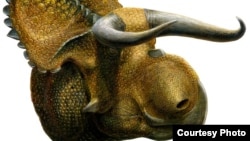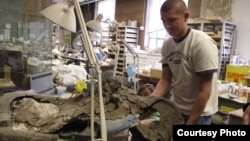A new species of horned dinosaur has been unearthed in Grand Staircase Escalante National Monument in the high rugged desert of southern Utah. Nasutoceratops - which means big-nosed horn face - lived 76 million years ago, in the late Cretaceous period, in what was then a subtropical swampy environment.
Scott Sampson, chief curator with the Natural History Museum at the University of Utah, led the excavation that found what appears to be a new branch of the horned dinosaur family tree. He said Nasutoceratops' skull has a significantly different set of horns than its well-known cousin, Triceratops.
“It’s unique in having this tiny little horn over the nose and then these big long horns over the eyes, which is very different from the closest relative, within that group of horned dinosaurs," he said.
The four-legged herbivore measured about five meters from head to tail and weighed about 2.5 tons. Sampson said the discovery includes a nearly complete skull, 1.5 meters long, and pieces of two or three other skulls.
“With that mostly complete skull there is a neck and part of the back, that is the vertebrae in the backbone," he said. "We also have a forelimb shoulder and forelimb all the way down to the foot on that one animal. So, we’re missing the back end of Nasutoceratops right now.”
The vast 800,000-hectare Grand Staircase- Escalante National Monument is the last great dinosaur boneyard in the United States. For most of the Late Cretaceous period, a warm, shallow sea extended from what is now the Arctic Ocean to the Gulf of Mexico, subdividing North American into eastern and western landmasses, known as Appalachia and Laramidia, respectively. Laramidia was the same size as current day Australia. Beginning in the 1960s, paleontologists began to notice the same major groups of dinosaurs over Laramidia, but different species of these groups occurred in the north and south.
Nasutoceratops will be on permanent display at the Natural History Museum of Utah. The discovery was announced in the British scientific journal, "Proceedings of the Royal Society B."









